

Mobile.reuters. " #PrivacyShield : l’Europe demande des garanties aux Etats-Unis " Privacy Shield : l’Europe demande des garanties aux Etats-Unis. L’accord transatlantique de protection des données pourrait être remis en cause par le nouveau gouvernement américain.
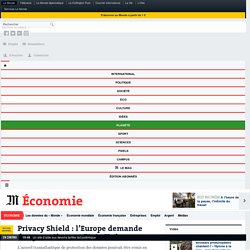
En apparence technique, le sujet a tout de la bombe politique. L’administration Trump respectera-t-elle le Privacy Shield, cet accord transatlantique sur l’échange des données ? La publication le 25 janvier d’un « Executive Order » par le 45e président des Etats-Unis a mis le feu aux poudres. Dans un article modifiant le Privacy Act (la loi qui précise la collecte, et l’utilisation des informations des individus), le nouveau gouvernement indiquait que dorénavant la protection des données personnelles dans le cadre des enquêtes de police ne s’appliquerait plus aux non-Américains. Dans les esprits, cette modification de la loi était de nature à remettre en cause l’accord négocié l’année dernière entre la Commission européenne et le gouvernement Obama.
Demande de confirmation écrite A Bercy, on soutient l’initiative.... [Communiqué G29] Séance plénière du G29 des 12 et 13 décembre 2016. The Privacy Advisor Podcast: Max Schrems by Privacy Professionals. Max Schrems (@maxschrems) Max Schrems.
Adoption d’un accord entre l’UE et les Etats-Unis sur les données personnelles. Le Parlement européen a donné son aval, le 1er décembre, à un accord négocié entre l’UE et les Etats-Unis pour mieux garantir la protection des données personnelles échangées entre les autorités policières et judiciaires américaines et européennes.
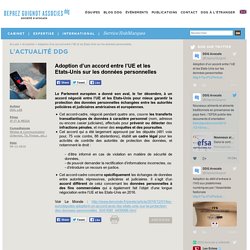
Cet accord-cadre, négocié pendant quatre ans, couvre les transferts transatlantiques de données à caractère personnel (nom, adresse ou encore casier judiciaire), effectués pour prévenir ou détecter des infractions pénales, et mener des enquêtes et des poursuites.Cet accord qui a été largement approuvé par les députés (481 voix pour, 75 voix contre, 88 abstentions), établit un cadre légal pour les activités de contrôle des autorités de protection des données, et notamment le droit : - d’être informé en cas de violation en matière de sécurité de données,- de pouvoir demander la rectification d’informations incorrectes, ou- d’introduire un recours en justice.
Voir Le Monde : DATA TRANSFERS, SAFE HARBOUR AND THE EU/US PRIVACY SHIELD — Risk & Compliance. Last October’s ground breaking decision from the Court of Justice of the European Union (ECJ) on the US Safe Harbour has sent ripples through the transatlantic business community.

The judgement not only affects US businesses with subsidiaries in Europe, but IT-related service providers (particularly online services) with European customers. These businesses can no longer rely on the US Safe Harbour to transfer personal information relating to their employees, customers and suppliers from Europe to the US. WP29 Statement on Privacy Shield. The Article 29 Working Party has today issued a statement on the EU-US Privacy Shield adopted by the European Commission on 12th July 2016.
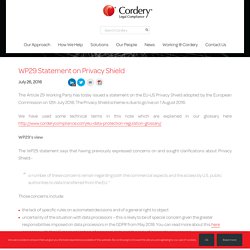
The Privacy Shield scheme is due to go live on 1 August 2016. We have used some technical terms in this note which are explained in our glossary here. Further Challenges to EU-US Privacy Shield and EU Data Exports. Privacy Shield Principles Permit Transfer of Personal Data Between United States and European Union.
To transfer personal data from the European Union ("EU") to the United States ("US"), a legal basis for the transfer must exist.

The EU and the US have agreed to new principles, referred to as Privacy Shield Principles ("Privacy Shield" or "Principles"), that will permit the transfer of personal data between the US and the EU if the transferring entity does not have in place approved binding corporate rules or model contract provisions. US organizations can self-certify that they are in compliance with the Principles to enter Privacy Shield, thus permitting the transfer of personal data to the US entity. Health care organizations should consider whether they should require vendors to self-certify or if an alternative, such as model contract provisions, are a better approach to prevent a disruption in the ability to transfer personal data. Background. EU-US Privacy Shield in force. On July 8, the EU Member States adopted the EU-US Privacy Shield by a large majority.
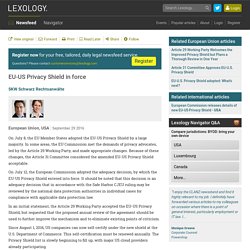
In some areas, the EU Commission met the demands of privacy advocates, led by the Article 29 Working Party, and made appropriate changes. Because of these changes, the Article 31 Committee considered the amended EU-US Privacy Shield acceptable. On July 12, the European Commission adopted the adequacy decision, by which the EU-US Privacy Shield entered into force. It should be noted that this decision is an adequacy decision that in accordance with the Safe Harbor CJEU ruling may be reviewed by the national data protection authorities in individual cases for compliance with applicable data protection law. Legal challenge to model clauses should prompt Privacy Shield extension, says expert. If a legal challenge to model contract clauses is successful then banks, insurers and telcos will need another way to transfer data, but at the moment that could not be the Privacy Shield.
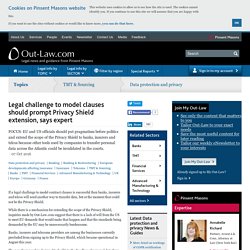
Privacy group launches legal challenge against EU-U.S. data pact. By Julia Fioretti and Dustin Volz| BRUSSELS/WASHINGTON BRUSSELS/WASHINGTON A widely expected legal challenge has been filed by an Irish privacy advocacy group to an EU-U.S. commercial data transfer pact underpinning billions of dollars of trade in digital services just two months after it came into force, sources said.

The EU-U.S. Privacy Shield was agreed earlier this year after the European Union's highest court struck down the previous Safe Harbour agreement over the transfer of Europeans' personal data to the United States, on concerns about intrusive U.S. surveillance. The new agreement gives businesses moving personal data across the Atlantic - from human resources information to people's browsing histories to hotel bookings - an easy way to do so without falling foul of tough EU data transferral rules. Digital Rights Ireland declined to comment. Update: EU-US Privacy Shield in Kraft. EU-U.S. Privacy Shield passes: Now what? It’s baaaack: The European Commission this month formally adopted the long-awaited transatlantic data transfer framework, establishing stringent new data privacy compliance obligations on U.S. companies seeking to transfer personal data from Europe into the United States.
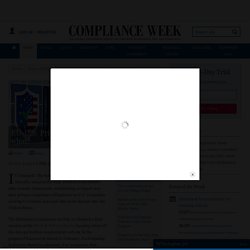
The European Commission on July 12 adopted a final version of the EU-U.S. Privacy Shield, keeping intact all the data protection requirements set out in the proposed framework issued in February. Participating in Privacy Shield is voluntary. For companies that choose to participate, however, any non-compliance with Privacy Shield principles will be enforceable under U.S. law by the relevant enforcement authority, either the U.S. Federal Trade Commission (FTC) or the U.S. A Practical Guide to the EU-US Privacy Shield - Privacy, Security and Information Law Fieldfisher. In all the talk and commentary about the EU-US Privacy Shield, what often gets lost is the one issue that is of primary importance to US businesses – what do US companies actually need to do to self-certify to the Shield?
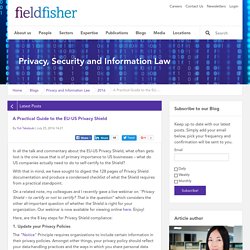
With that in mind, we have sought to digest the 128 pages of Privacy Shield documentation and produce a condensed checklist of what the Shield requires from a practical standpoint. On a related note, my colleagues and I recently gave a live webinar on "Privacy Shield – to certify or not to certify? That is the question" which considers the other all-important question of whether the Shield is right for your organization. Our webinar is now available for viewing online here. Enjoy! New Privacy Shield Could Face Legal Challenge in Europe, Experts Say - CIO Journal.
Privacy Shield: A victory for the transatlantic economy – EurActiv.com. The EU-US Privacy Shield goes live today (1 August). Věra Jourová and Penny Pritzker argue that this is good for citizens, businesses and the economy on both sides of the Atlantic. Penny Pritzker is US Commerce Secretary and Věra Jourová is EU Justice Commissioner. Daily News 01 / 08 / 2016. EU-U.S. Privacy Shield fully operational from today [updated: 01 / 08 / 2016 at 12:38] Aaron Simpson Speaks with Numerous News Outlets on EU-US Privacy Shield.
Europe unhappy with Privacy Shield, holding off until 2017. July 28, 2016 Europe's data protection committee is going to let Privacy Shield operate for a year, promising to hold off on legal challenges until its first joint annual review happens in 2017. European Commission HQ Europe's data protection committee Working Party 29 (WP29) is going to let Privacy Shield operate for a year, promising to hold off on legal challenges until mid-2017 when its first joint annual review is held. While the chest-beating is still ongoing, the agreement should bring much needed breathing room for corporations which rely on transatlantic data transfers. Registration. The EU US Privacy Shield: To certify or not to certify? That is the question.
Privacy Shield: US companies have time to update data sharing contracts. 20160726_wp29_wp_statement_eu_us_privacy_shield_en. 20160726_wp29_wp_statement_eu_us_privacy_shield_en. Privacy Shield will not survive legal challenge, says Schrems. Austrian activist Max Schrems reckons the latest data-sharing deal between the EU and US unveiled on Tuesday (12 July) is vulnerable to legal challenges, and will not last long.
“The European Commission is jumping from one ice-floe to another. It knows it will sink sooner or later, but keeps jumping in the meantime," Schrems told journalists at the European Parliament on Tuesday. He was speaking just before the deal - known as Privacy Shield - was officially announced by justice commissioner Vera Jourova. Jourova said the deal brought to a close "more than two and a half years of work since the Commission first raised concerns about the old Safe Harbour arrangement and whether it was really safe enough to protect the fundamental rights of Europeans".
Member states gave it the go-ahead last Friday. The European Court of Justice (ECJ) outlawed Safe Harbour, the previous framework, in October 2015, acting on a case brought by Schrems. EU and US authorities have scrambled to replace the deal. EU-U.S. Privacy Shield: Frequently Asked Questions. What is the EU-US Privacy Shield? After two and half years of negotiations, the European Commission and the U.S. Department of Commerce on 2 February 2016 reached a agreement on a new framework for transatlantic exchanges of personal data for commercial purposes: the EU-U.S. Privacy Shield (IP/16/216).
This new framework will protect the fundamental rights of individuals where their data is transferred to the United States and ensure legal certainty for businesses. This blog discusses data protection law, practice and problems. EU-U.S. commercial data transfer pact clears final hurdle. Official: Privacy Shield dragged across finish line. Updated @ 13:08 GMT, July 8—As expected, the Article 31 committee of national representatives waved through Privacy Shield on Friday morning. Original story BRUSSELS—Privacy Shield—the much maligned replacement to the Safe Harbour deal between the European Union and the US—looks set to be approved by national representatives on Friday, Ars understands.
The scheme, which will allow the transfer of personal data from the EU to the US despite privacy and data protection concerns, has faced an uphill battle. Brussels officials who negotiated the deal on behalf of the EU have been desperate to push it through in the face of criticism from the European Data Protection Supervisor, national data protection authorities, and the European Parliament, in order to give some legal certainty to companies that rely on transatlantic data flows. Many businesses have been in legal limbo since the Safe Harbour agreement was ruled invalid by the European Court of Justice (CJEU) last year. Le Privacy Shield pas encore ratifié, mais déjà attaqué.
L’association Cloud Confidence avait choisi le Privacy Shield pour focus à l’occasion de la Cloud Independance Day, manifestation intégrée à la Cloud Week.